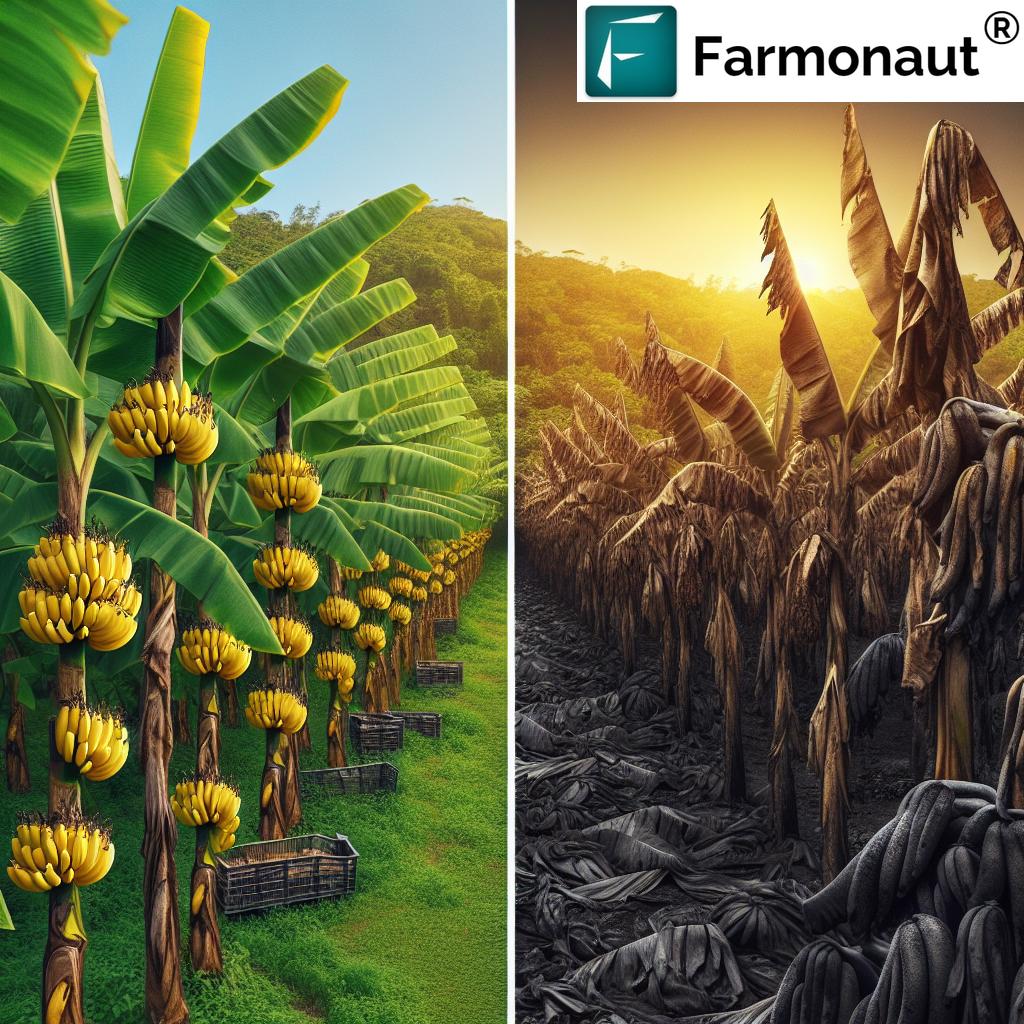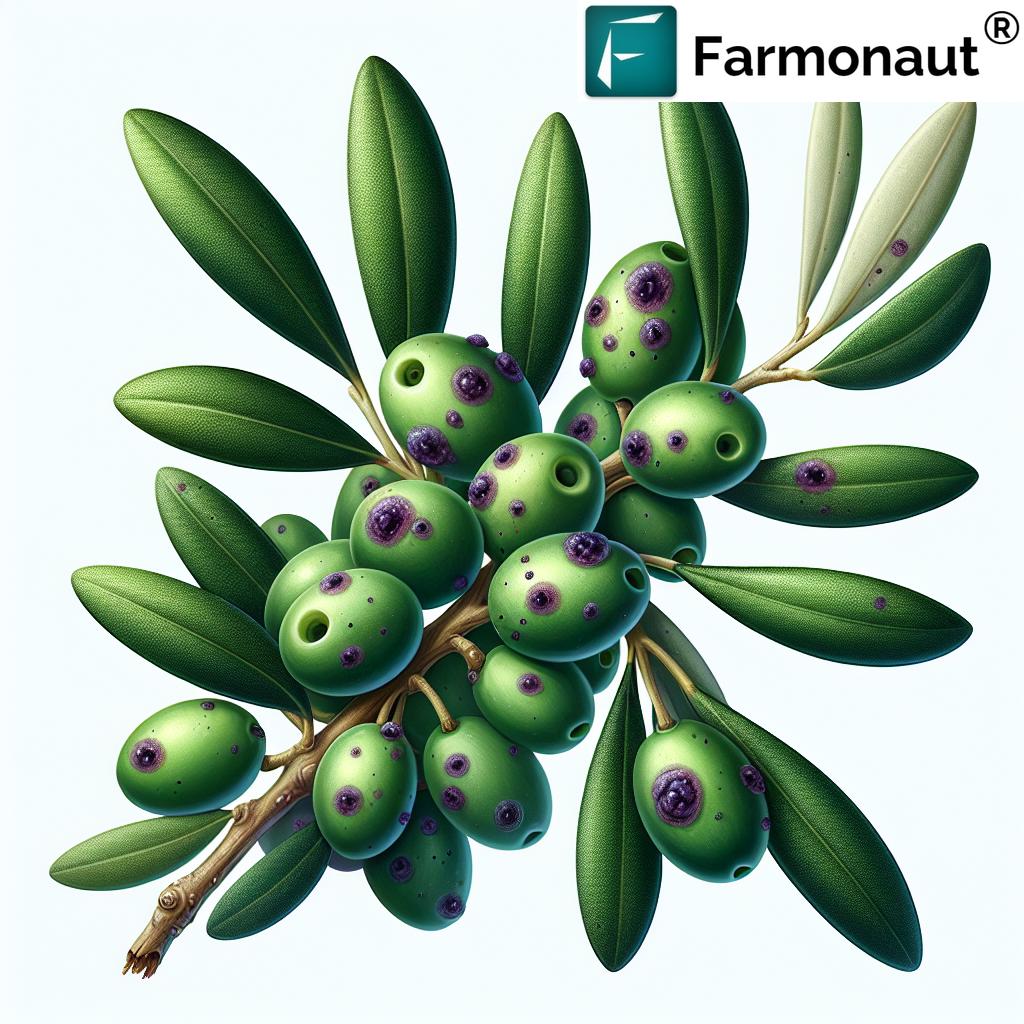Black Sigatoka: Organic and Chemical Control of Destructive Banana Fungal Disease

In the world of banana cultivation, few threats loom as large as Black Sigatoka, a devastating fungal disease that has become the bane of banana farmers worldwide. At Farmonaut, we understand the critical importance of managing this destructive pest effectively, and we’re committed to providing cutting-edge solutions to help farmers combat this menace. In this comprehensive guide, we’ll delve deep into the world of Black Sigatoka, exploring its causes, symptoms, and most importantly, the various control methods available to farmers today.
Understanding Black Sigatoka: A Formidable Foe
Black Sigatoka, also known as Black Leaf Streak Disease or by its scientific name Pseudocercospora fijiensis (formerly Mycosphaerella fijiensis), is a fungal disease that poses a significant threat to banana plantations globally. This destructive pathogen primarily affects the leaves of banana plants, causing severe damage that can lead to substantial yield losses if left unchecked.
The Lifecycle of Black Sigatoka
To effectively combat Black Sigatoka, it’s crucial to understand its lifecycle:
- Spore Production: The fungus produces spores on infected banana leaves.
- Dispersal: Spores are dispersed by wind and rain, spreading to nearby plants.
- Infection: Under favorable conditions (high humidity and temperature), spores germinate and penetrate the leaf tissue.
- Symptom Development: Infected leaves develop characteristic spots and streaks.
- Further Spread: As the disease progresses, more spores are produced, continuing the cycle.
Symptoms and Damage
Black Sigatoka manifests through several distinct stages:
- Early stages: Small, reddish-brown specks on the underside of leaves
- Progressive stages: Spots enlarge and turn dark brown or black
- Advanced stages: Spots coalesce, forming large necrotic areas
- Severe cases: Entire leaves may die and collapse
The damage caused by Black Sigatoka extends beyond mere cosmetic issues. Infected plants suffer from:
- Reduced photosynthetic capacity
- Premature ripening of fruit
- Significant yield losses (up to 50% or more in severe cases)
- Increased susceptibility to other pests and diseases
Factors Influencing Black Sigatoka Development
Several environmental and agronomic factors contribute to the development and spread of Black Sigatoka:
1. Climate Conditions
- Temperature: The fungus thrives in temperatures between 25-28°C (77-82°F).
- Humidity: High relative humidity (above 80%) favors spore germination and infection.
- Rainfall: Frequent rainfall or overhead irrigation can facilitate spore dispersal and create favorable conditions for infection.
2. Agronomic Practices
- Plant Density: Overcrowded plantations can create a microclimate conducive to disease development.
- Crop Residue Management: Infected plant residues can serve as a source of inoculum for future infections.
- Varietal Susceptibility: Some banana varieties are more susceptible to Black Sigatoka than others.
3. Geographical Location
Black Sigatoka is most prevalent in tropical and subtropical regions where bananas are grown commercially. However, with changing climate patterns, its range has been expanding to new areas.
Control Strategies: A Multi-Faceted Approach
Effectively managing Black Sigatoka requires a comprehensive approach that combines various control strategies. At Farmonaut, we advocate for an Integrated Pest Management (IPM) approach that incorporates both conventional and organic methods.
1. Cultural Control Methods
Cultural practices play a crucial role in preventing and managing Black Sigatoka:
- Proper Plant Spacing: Ensure adequate spacing between plants to improve air circulation and reduce humidity within the canopy.
- Leaf Pruning: Regular removal of infected leaves can help reduce the inoculum load in the plantation.
- Field Sanitation: Proper disposal of infected plant material to prevent the fungus from surviving on crop residues.
- Water Management: Avoid overhead irrigation and manage drainage to reduce leaf wetness duration.
- Nutrient Management: Maintain optimal plant nutrition to enhance plant resistance to the disease.
2. Resistant Varieties
Planting resistant or tolerant banana varieties is one of the most effective long-term strategies for managing Black Sigatoka. Some promising resistant varieties include:
- FHIA-01 (Goldfinger)
- FHIA-17
- FHIA-23
- FHIA-25
While these varieties show improved resistance, it’s important to note that no banana variety is completely immune to Black Sigatoka. Continuous breeding efforts are underway to develop new varieties with enhanced resistance.
3. Chemical Control
Chemical fungicides remain a crucial tool in the management of Black Sigatoka, especially in large-scale commercial plantations. However, their use must be carefully managed to prevent the development of fungicide resistance.
Types of Fungicides Used:
- Protectant Fungicides: These are applied preventatively and form a protective barrier on the leaf surface. Examples include mancozeb and chlorothalonil.
- Systemic Fungicides: These are absorbed by the plant and can provide curative action. Examples include triazoles (e.g., propiconazole) and strobilurins (e.g., azoxystrobin).
Best Practices for Chemical Control:
- Rotate between fungicides with different modes of action to prevent resistance development.
- Apply fungicides at recommended rates and intervals.
- Use forecasting systems to optimize timing of fungicide applications.
- Integrate chemical control with other management strategies for best results.
4. Biological Control
While still an emerging field, biological control shows promise in managing Black Sigatoka. Some potential biocontrol agents include:
- Bacillus subtilis
- Trichoderma species
- Various mycoparasitic fungi
These beneficial microorganisms can help suppress the pathogen through various mechanisms such as competition, antibiosis, or induced plant resistance.
5. Organic Control Methods
For organic banana production or farmers looking to reduce chemical inputs, several organic control methods can be employed:
- Compost Tea: Foliar applications of compost tea can enhance plant resistance and suppress disease development.
- Biofertilizers: Products containing beneficial microorganisms can improve plant health and resistance.
- Plant Extracts: Certain plant-based preparations (e.g., neem oil) may have fungicidal properties.
- Silicon: Foliar applications of silicon have shown promise in reducing Black Sigatoka severity in some studies.
The Role of Technology in Black Sigatoka Management
At Farmonaut, we’re at the forefront of leveraging technology to revolutionize pest and disease management in agriculture. Our satellite-based monitoring system offers significant advantages in the early detection and management of Black Sigatoka.
Farmonaut’s Satellite Monitoring vs. Traditional Monitoring
| Feature | Traditional Monitoring | Farmonaut Satellite Monitoring |
|---|---|---|
| Early Detection | Limited to visual inspections | Detects early signs of stress before visible symptoms appear |
| Coverage Area | Limited to accessible areas | Covers entire plantations, even remote or difficult-to-access areas |
| Frequency | Dependent on manual inspections | Regular updates based on satellite revisit times |
| Accuracy | Subject to human error | High accuracy through advanced image analysis algorithms |
| Cost-effectiveness | Labor-intensive and time-consuming | Highly cost-effective for large-scale monitoring |
By utilizing Farmonaut’s satellite monitoring system, banana farmers can:
- Detect early signs of Black Sigatoka infestation before visible symptoms appear
- Monitor large areas efficiently and regularly
- Implement targeted control measures, reducing overall fungicide use
- Track the effectiveness of control strategies over time
- Make data-driven decisions for improved disease management
To learn more about how Farmonaut can help you manage Black Sigatoka and other banana diseases, visit our application page or explore our API documentation for integration with your existing farm management systems.
Integrated Management: The Key to Success
While each control method has its merits, the most effective approach to managing Black Sigatoka is through an integrated strategy that combines multiple methods. This approach, known as Integrated Pest Management (IPM), offers several advantages:
- Reduced reliance on chemical fungicides
- Improved long-term sustainability of banana production
- Enhanced environmental stewardship
- Better resistance management
- Potential cost savings through optimized resource use
Steps to Implement an Integrated Black Sigatoka Management Program:
- Monitor and Assess: Regularly monitor your plantation for signs of Black Sigatoka. Farmonaut’s satellite monitoring system can be a valuable tool in this step.
- Identify Risk Factors: Understand the environmental and agronomic factors that contribute to disease development in your specific location.
- Set Action Thresholds: Determine at what level of disease pressure control measures need to be implemented.
- Implement Cultural Practices: Adopt good agronomic practices that create an environment less favorable for disease development.
- Use Resistant Varieties: Where possible, plant banana varieties with improved resistance to Black Sigatoka.
- Apply Biological Controls: Incorporate beneficial microorganisms into your management program.
- Judicious Use of Fungicides: When necessary, apply fungicides according to best practices to minimize resistance development.
- Evaluate and Adjust: Continuously assess the effectiveness of your management program and make adjustments as needed.
The Future of Black Sigatoka Management
As we look to the future, several promising developments are on the horizon for Black Sigatoka management:
1. Advanced Breeding Programs
Ongoing research in banana breeding is focused on developing new varieties with enhanced resistance to Black Sigatoka while maintaining desirable agronomic and consumer traits. Techniques such as genetic engineering and CRISPR gene editing may accelerate the development of resistant varieties.
2. Novel Biocontrol Agents
The search for effective biological control agents continues, with researchers exploring diverse microorganisms and their potential in suppressing Black Sigatoka. Advancements in microbial ecology and genomics are expected to yield new and more effective biocontrol solutions.
3. Precision Agriculture Technologies
The integration of technologies like Farmonaut’s satellite monitoring system, along with other precision agriculture tools such as drones and IoT sensors, will enable more targeted and efficient disease management strategies.
4. Climate-Smart Agriculture
As climate change continues to impact banana production regions, developing climate-resilient management strategies for Black Sigatoka will become increasingly important. This may involve adapting cultural practices, breeding for heat and drought tolerance, and implementing advanced forecasting systems.
5. Sustainable Chemical Solutions
Research into new fungicide chemistries and formulations continues, with a focus on developing products that are both effective against Black Sigatoka and environmentally sustainable.
Case Study: Successful Black Sigatoka Management in Costa Rica
Costa Rica, one of the world’s leading banana exporters, has been at the forefront of implementing integrated Black Sigatoka management strategies. Here’s a brief overview of their approach:
- Early Warning System: Implementation of a nationwide disease forecasting system based on weather data and spore trapping.
- Optimized Fungicide Use: Adoption of a systematic fungicide rotation program to manage resistance.
- Cultural Practices: Widespread implementation of leaf pruning and improved drainage systems.
- Biological Control: Experimental use of beneficial microorganisms in selected plantations.
- Technology Adoption: Integration of satellite monitoring and GIS technologies for improved disease tracking and management.
The result has been a significant reduction in fungicide use (up to 30% in some areas) while maintaining high productivity and fruit quality. This success story demonstrates the potential of integrated approaches in managing Black Sigatoka effectively and sustainably.
Conclusion: A Call to Action
Black Sigatoka remains one of the most significant challenges facing banana producers worldwide. However, with a comprehensive understanding of the disease and a commitment to integrated management strategies, it is possible to mitigate its impact and ensure sustainable banana production.
At Farmonaut, we’re dedicated to empowering farmers with the tools and knowledge they need to combat threats like Black Sigatoka effectively. Our satellite monitoring system, coupled with advanced analytics and expert advisory services, provides a powerful solution for early detection and management of this destructive disease.
We encourage all banana growers to:
- Stay informed about the latest developments in Black Sigatoka management
- Implement integrated management strategies tailored to your specific conditions
- Leverage technology like Farmonaut’s satellite monitoring to enhance your disease management efforts
- Collaborate with researchers, extension services, and fellow growers to share knowledge and best practices
Together, we can work towards a future where Black Sigatoka no longer poses a significant threat to global banana production. To learn more about how Farmonaut can support your efforts in managing Black Sigatoka and other agricultural challenges, visit our website or download our mobile app:
For developers interested in integrating our satellite monitoring capabilities into their own applications, check out our API documentation.
FAQs about Black Sigatoka Management
-
Q: How quickly can Black Sigatoka spread in a banana plantation?
A: Black Sigatoka can spread rapidly under favorable conditions. In susceptible varieties, the disease can progress from initial infection to severe symptoms within 3-4 weeks.
-
Q: Can Black Sigatoka be completely eradicated from a plantation?
A: Complete eradication is extremely difficult once Black Sigatoka is established. The focus should be on effective management to keep disease levels below economic thresholds.
-
Q: Are organic methods effective in controlling Black Sigatoka?
A: Organic methods can be effective as part of an integrated management approach, especially in smaller plantations. However, they may be challenging to implement in large-scale commercial operations without some yield loss.
-
Q: How does climate change affect Black Sigatoka management?
A: Climate change can alter disease patterns and severity. Increased temperatures and changes in rainfall patterns may favor disease development in some regions while potentially reducing pressure in others.
-
Q: Is it safe to eat bananas from trees infected with Black Sigatoka?
A: Yes, it’s safe to eat bananas from infected trees. Black Sigatoka affects the leaves but does not directly impact the fruit. However, severe infections can affect fruit quality and yield.

Subscribe to Farmonaut
Ready to take your banana farming to the next level? Subscribe to Farmonaut today and gain access to our cutting-edge satellite monitoring system, expert advisory services, and more!













